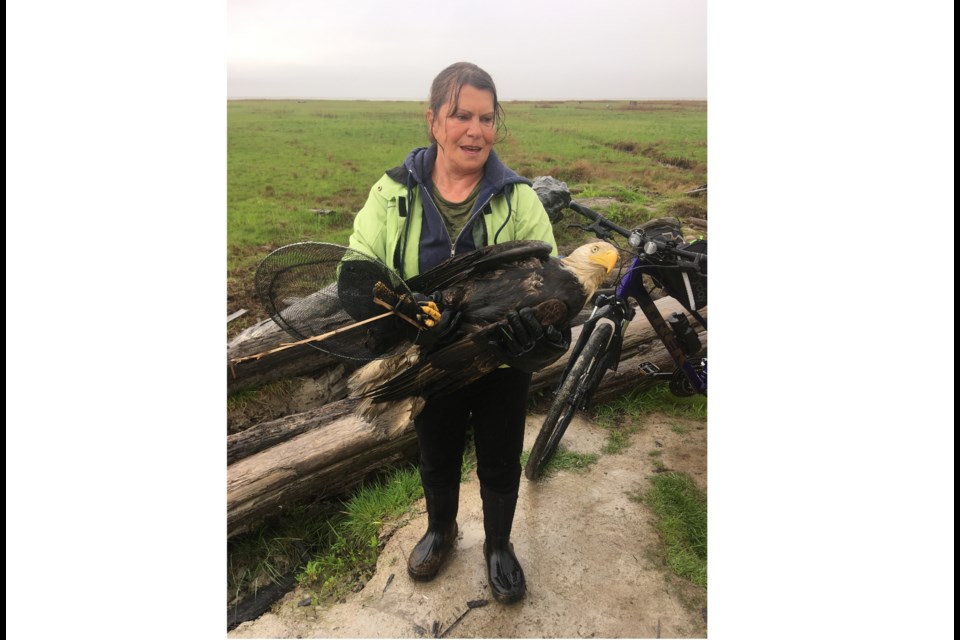A bald eagle’s rough Sunday evening could have ended a lot worse had it not been for some keen-eyed locals walking the dyke.
The bird of prey was spotted by the dyke near Terra Nova. Bystanders knew something was wrong when she didn’t fly away -- even as a pack of coyotes started closing in.
“It was hopping from log to log, not able to take flight when I got there. The coyotes were still around, watching. I think they wanted that meal,” said Therese Ducharme, a volunteer at the OWL (Orphaned Wildlife) Rehabilitation Society in Delta. Those who spotted the struggling eagle had contacted OWL for assistance, as it is a non-profit dedicated to helping raptors.
Armed with her trusty leather eagle gloves and with the help of a young man, Ducharme was able to corral the eagle off the logs and into a more open area where it was put into a net.
Though the rescue took less than an hour, it was quite a work-out in the torrential rain, she said. A good amount of the time was spent on running after the eagle, even though all it could do was hop, and Ducharme also had to carry her back to safety.
“This is a female, so a bigger eagle. But they’re also very strong and when you’re carrying them, you want to make sure they’re secure. So you’re hanging on, and your arm, after walking [half a mile back], it tends to cramp up,” said Ducharme.
By the time Ducharme had the eagle back at her car, the pair was drenched.
Bystanders were very encouraging and even helped Ducharme put her spare boxes together to contain the injured bird. They also kept on lookout for the hungry coyotes, said Ducharme.
“[The coyotes] were kind of keeping us in sight. Just in case, I think. Just in case.”
Life after rescue
The bald eagle is now being monitored in intensive care, while rehabbers try to figure out what happened to her. All they know now is that she has a droopy wing, which could take up to 60 days to heal if it’s a bone injury.
“There is a possibility that she hit the powerlines and she ended up out in the dyke there. With electricity, it’s usually two to 10 days to show up the severity of the injury,” said Rob Hope, the general manager at OWL.
“We sort of have to CSI it. If they told us the story, our job would be easier. But unfortunately, they can’t talk to us,” Hope added.
Electrocution is one of the most common reasons for rescues in Richmond, but OWL has also helped birds of prey who were orphaned, hit by cars or windows, injured in fights, or suffering from lead or rodenticide poisoning.
OWL has ruled out lead poisoning for this damsel in distress, and all that is left to do is to give her time and tender loving care so she can eventually be released back into the wild.
“If we rule everything out and her wings seem to be working, we’ll put her into a bigger flight cage. We have steps that we take throughout the rehab process to slowly build those wings back up. The final cage will be a 300-ft eagle flight pen or a 180-ft flight pen for her to really make sure that wing is working properly before she goes,” said Hope.
Helping raptors in distress
Without bystanders carefully monitoring the situation, the rescue might have ended differently, said Ducharme.
“I’m so happy that people are walking and looking around and spotting the birds when they’re in distress,” she added.
Bald eagles and other raptors such as barn owls can often be seen in Richmond, especially during the winter, and gathering as much information as possible will help rescuers at OWL better assess the situation.
Some signs of distress to look out for include when raptors don’t fly away even when they’re approached by humans or dogs, when they’re flying in a lopsided way, or if there is a large amount of blood.



